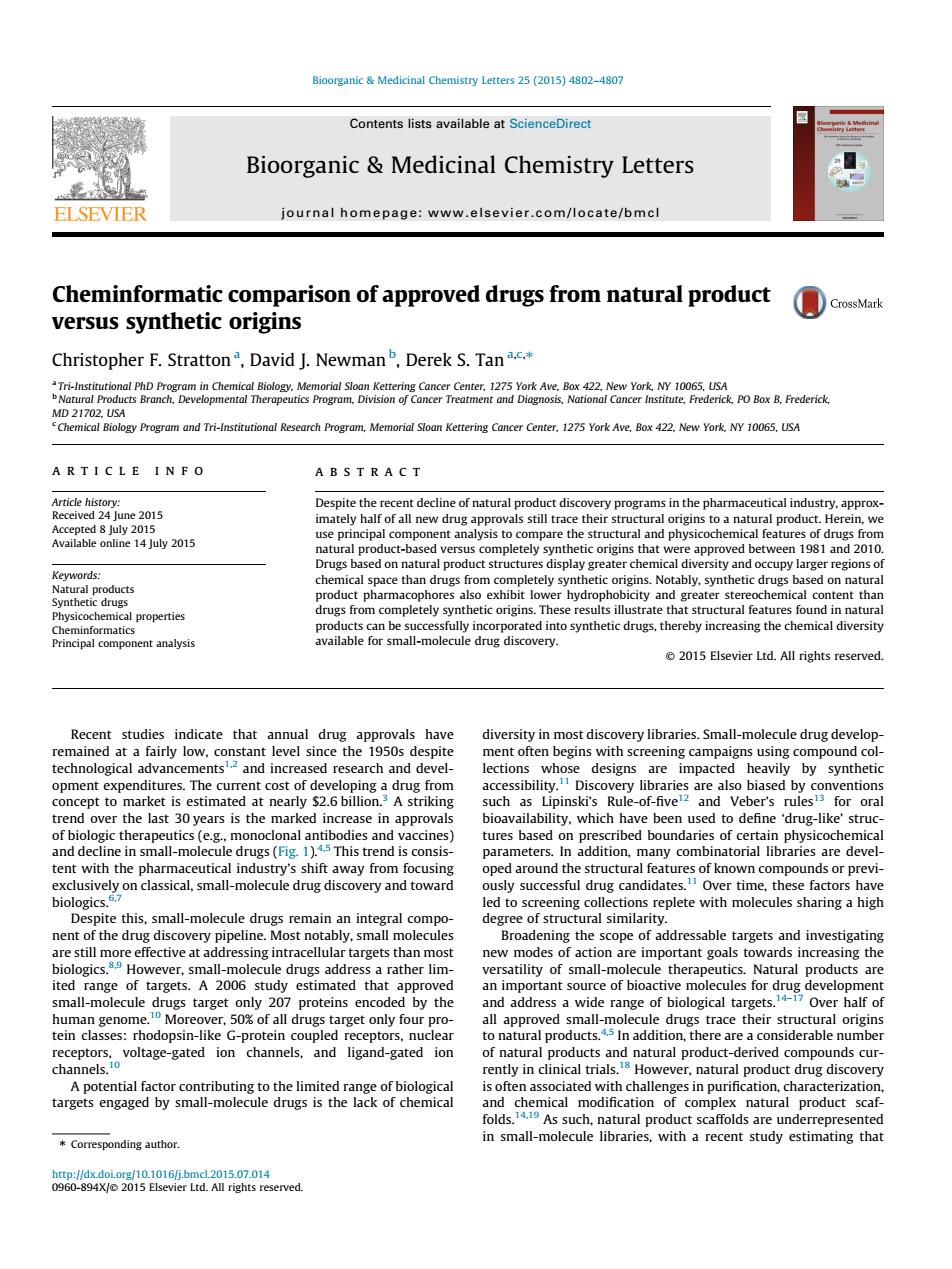正在加载图片...

Contents lists available at sciencedirect Bioorganic Medicinal Chemistry Letters ELSEVIER journal homepage:www.elsevier.com/locate/bmcl Cheminformatic comparison of approved drugs from natural product versus synthetic origins Christopher F.Stratton,David J.Newman,Derek S.Tan D21702U ad-ReseachPgm Memr m Ketering Cancer Center.1275 York Ave.Bx 4.New York NY10065.USA ARTICLE INFO ABSTRACT ne2015 and 201 ely syn syn etic drugs perties 015 Elsevier Ltd.All rights reserved. diversity in most discovery libraries.Small-molecule drug develop end is couin rameters.n orialibrar& esre deve xinccmll-moecuedrugdiscoveryw usly successful drug candidates. ehl-moiecule drugn small-m target ony proteins encode by the d address awd de range of biologica targets er half o Tentincdhnicaltnalk月 and chem lex natural product scaf mall- nt s that 8do0eIg0Leud1igeaened Cheminformatic comparison of approved drugs from natural product versus synthetic origins Christopher F. Stratton a , David J. Newman b , Derek S. Tan a,c,⇑ a Tri-Institutional PhD Program in Chemical Biology, Memorial Sloan Kettering Cancer Center, 1275 York Ave, Box 422, New York, NY 10065, USA bNatural Products Branch, Developmental Therapeutics Program, Division of Cancer Treatment and Diagnosis, National Cancer Institute, Frederick, PO Box B, Frederick, MD 21702, USA c Chemical Biology Program and Tri-Institutional Research Program, Memorial Sloan Kettering Cancer Center, 1275 York Ave, Box 422, New York, NY 10065, USA article info Article history: Received 24 June 2015 Accepted 8 July 2015 Available online 14 July 2015 Keywords: Natural products Synthetic drugs Physicochemical properties Cheminformatics Principal component analysis abstract Despite the recent decline of natural product discovery programs in the pharmaceutical industry, approximately half of all new drug approvals still trace their structural origins to a natural product. Herein, we use principal component analysis to compare the structural and physicochemical features of drugs from natural product-based versus completely synthetic origins that were approved between 1981 and 2010. Drugs based on natural product structures display greater chemical diversity and occupy larger regions of chemical space than drugs from completely synthetic origins. Notably, synthetic drugs based on natural product pharmacophores also exhibit lower hydrophobicity and greater stereochemical content than drugs from completely synthetic origins. These results illustrate that structural features found in natural products can be successfully incorporated into synthetic drugs, thereby increasing the chemical diversity available for small-molecule drug discovery. 2015 Elsevier Ltd. All rights reserved. Recent studies indicate that annual drug approvals have remained at a fairly low, constant level since the 1950s despite technological advancements1,2 and increased research and development expenditures. The current cost of developing a drug from concept to market is estimated at nearly $2.6 billion.3 A striking trend over the last 30 years is the marked increase in approvals of biologic therapeutics (e.g., monoclonal antibodies and vaccines) and decline in small-molecule drugs (Fig. 1).4,5 This trend is consistent with the pharmaceutical industry’s shift away from focusing exclusively on classical, small-molecule drug discovery and toward biologics.6,7 Despite this, small-molecule drugs remain an integral component of the drug discovery pipeline. Most notably, small molecules are still more effective at addressing intracellular targets than most biologics.8,9 However, small-molecule drugs address a rather limited range of targets. A 2006 study estimated that approved small-molecule drugs target only 207 proteins encoded by the human genome.10 Moreover, 50% of all drugs target only four protein classes: rhodopsin-like G-protein coupled receptors, nuclear receptors, voltage-gated ion channels, and ligand-gated ion channels.10 A potential factor contributing to the limited range of biological targets engaged by small-molecule drugs is the lack of chemical diversity in most discovery libraries. Small-molecule drug development often begins with screening campaigns using compound collections whose designs are impacted heavily by synthetic accessibility.11 Discovery libraries are also biased by conventions such as Lipinski’s Rule-of-five12 and Veber’s rules13 for oral bioavailability, which have been used to define ‘drug-like’ structures based on prescribed boundaries of certain physicochemical parameters. In addition, many combinatorial libraries are developed around the structural features of known compounds or previously successful drug candidates.11 Over time, these factors have led to screening collections replete with molecules sharing a high degree of structural similarity. Broadening the scope of addressable targets and investigating new modes of action are important goals towards increasing the versatility of small-molecule therapeutics. Natural products are an important source of bioactive molecules for drug development and address a wide range of biological targets.14–17 Over half of all approved small-molecule drugs trace their structural origins to natural products.4,5 In addition, there are a considerable number of natural products and natural product-derived compounds currently in clinical trials.18 However, natural product drug discovery is often associated with challenges in purification, characterization, and chemical modification of complex natural product scaffolds.14,19 As such, natural product scaffolds are underrepresented in small-molecule libraries, with a recent study estimating that http://dx.doi.org/10.1016/j.bmcl.2015.07.014 0960-894X/ 2015 Elsevier Ltd. All rights reserved. ⇑ Corresponding author. Bioorganic & Medicinal Chemistry Letters 25 (2015) 4802–4807 Contents lists available at ScienceDirect Bioorganic & Medicinal Chemistry Letters journal homepage: www.elsevier.com/locate/bmcl��